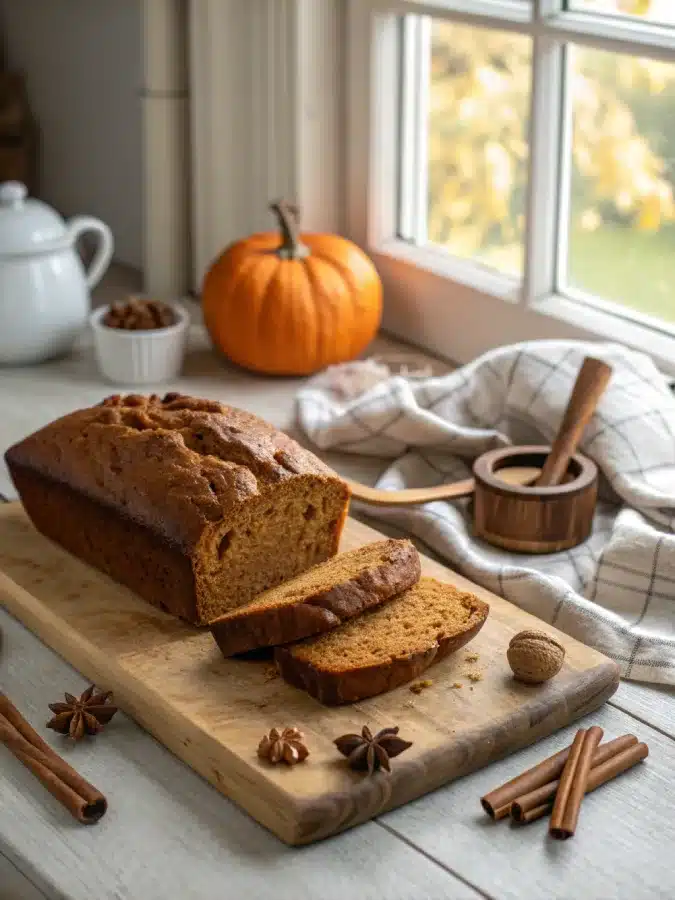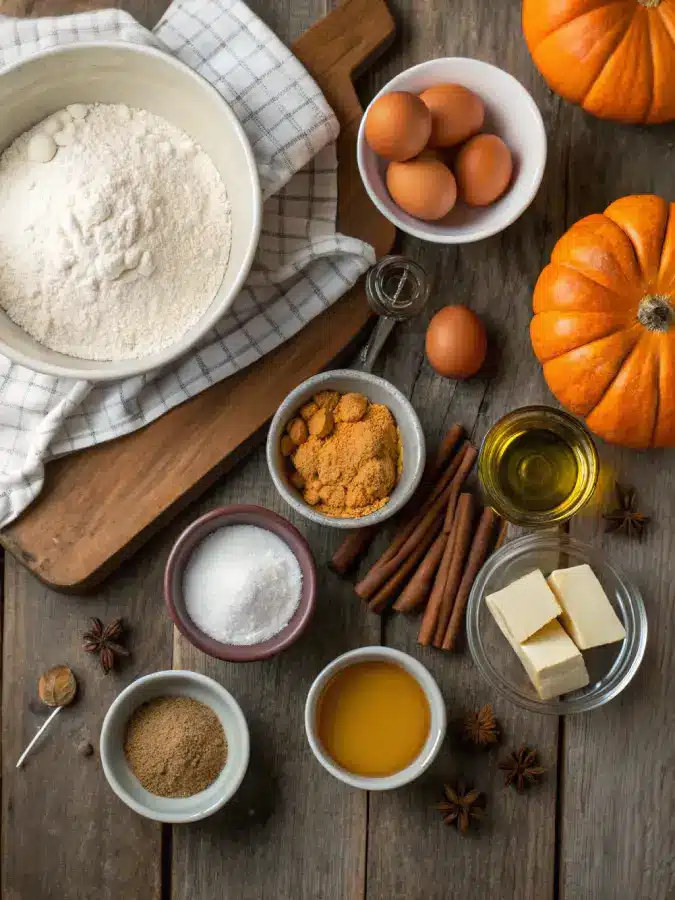
Pumpkin bread recipe searches spike every fall, and for good reason, it’s the kind of cozy, forgiving bake that fills your kitchen with warmth. This isn’t just a treat; it’s a seasonal ritual. Whether you’re a first-time baker or refining your go-to loaf, this guide covers everything: how to avoid bland flavor, what ingredients matter most, and how to keep your bread moist. I’ll share my tried-and-true method, the story behind it, and pro tips for freezing, storing, and serving. If you’re craving a loaf that’s rich, spiced, and never dry, you’re in the right place.
In this Article
Key Takeaways: What You Need To Know
Pumpkin bread is one of those cozy fall treats that everyone should have in their baking rotation. This recipe is simple, incredibly moist, and perfectly spiced, no fancy equipment needed. You’ll learn how to avoid flavorless or sunken loaves, whether to use butter or oil, and exactly how to freeze pumpkin bread for later. Let’s jump in.
The Story & Intro
There’s something about a loaf of pumpkin bread cooling on the counter that just feels like home. I still remember the first time I made one. It was early October, and the leaves outside were just starting to change. I had a can of pumpkin purée, some cinnamon, and zero expectations. But what came out of the oven? A beautifully golden loaf that made the whole house smell like comfort.
Since then, this pumpkin bread recipe has become a staple in my kitchen. I’ve tweaked it a dozen different ways, less sugar, more spice, butter, oil, and landed on a version that’s moist, rich, and deeply flavorful. Whether you’re baking for a cozy breakfast, a lunchbox snack, or just because you need something sweet with your afternoon tea, this one hits the spot every time.
The best part? You don’t need any fancy equipment. Just a few bowls, a whisk, and an oven. With pantry staples like flour, eggs, sugar, and canned pumpkin, you’re probably halfway there already. And if you’re feeling adventurous, I’ve even served it alongside a scoop of spiced whipped cream or added chopped nuts for a bit of crunch.
If you enjoy other baking favorites like my Paula Deen Carrot Cake or the fall-favorite Pumpkin Cheesecake, this pumpkin bread recipe is going to feel like a warm hug in every bite.
So, grab your apron and let’s bake some memories.
Pumpkin Bread Ingredients & Essentials

Pantry Staples That Make This Pumpkin Bread Recipe Work
At its heart, a great pumpkin bread recipe starts with simple, reliable ingredients. The core of this recipe is canned pumpkin purée, not pumpkin pie filling. This is where most beginners slip up. Using the wrong type of pumpkin can lead to an overly sweet or strangely textured loaf. For best results, always go for 100% pure pumpkin purée.
Next comes flour. Regular all-purpose flour works just fine for this pumpkin bread recipe, giving it structure without being too dense. Granulated sugar adds sweetness, while a bit of brown sugar deepens the flavor and gives that beautiful caramel-like note you want in a fall loaf.
The eggs help bind everything together, and vanilla extract adds warmth. Baking soda is the leavening agent of choice here, and just a little bit of salt balances the sweetness.
Whether you’ve made a Cracker Barrel Corn Casserole or a Crock Pot Mac and Cheese, you’ll recognize the rhythm of gathering ingredients that feel basic but transform into something cozy and crave-worthy.
Choosing the Right Spices for Your Pumpkin Bread Recipe
Spices are what really bring a pumpkin bread recipe to life. Classic options include ground cinnamon, nutmeg, cloves, and ginger. You can use a pre-mixed pumpkin spice blend if you’re short on time, but mixing your own often creates a deeper, richer flavor.
Freshly grated nutmeg makes a noticeable difference. Just a pinch goes a long way. Don’t skip the cinnamon, it’s the backbone of the warmth in every slice.
And if you’re ever tempted to go overboard with cloves, remember: a little makes it festive; too much makes it bitter. Balance is key in this pumpkin bread recipe.
Step-by-Step Instructions Made Simple
Mixing the Wet and Dry for the Best Pumpkin Bread Recipe
Every pumpkin bread recipe relies on getting the mixing process just right. One of the most common mistakes home bakers make is overmixing the batter. When you overwork the flour, you develop too much gluten, and the result is a tough loaf instead of a soft, moist one.
Start by whisking together the dry ingredients, flour, baking soda, salt, and spices, in a large bowl. In a separate bowl, combine the eggs, both sugars, vanilla, and your star: the pumpkin purée. If you’re using oil (which we’ll cover more in the next section), now’s the time to whisk it in.
Once everything is well-blended separately, gently fold the wet into the dry using a spatula or wooden spoon. This step is crucial. A good pumpkin bread recipe doesn’t need an electric mixer. Just a few slow turns until the flour disappears into the orange batter is enough.
This method is similar to what you’d use in recipes like our Bruces Yams Sweet Potato Casserole, keep it simple and resist the urge to overwork the mixture.
Baking Like a Pro with Your Pumpkin Bread Recipe
Now pour the batter into a greased 9×5-inch loaf pan. Tap it gently on the counter to remove any air bubbles. For the best rise, bake your pumpkin bread recipe in a preheated oven at 350°F (175°C) for about 55 to 65 minutes. Don’t open the oven too early, it can cause your loaf to sink.
You’ll know your pumpkin bread recipe is done when a toothpick inserted into the center comes out clean or with a few moist crumbs. Let it cool in the pan for 10 minutes, then remove and transfer to a wire rack.
For flavor-packed results, wrap the cooled loaf tightly and let it rest overnight before slicing. Trust me, this little trick makes this pumpkin bread recipe even better the next day.
Flavor Failures and How to Fix Them
Common Flavor Mistakes in a Pumpkin Bread Recipe
If you’ve ever tried a pumpkin bread recipe that turned out bland, you’re not alone. The most common mistake is skimping on spices. A proper pumpkin bread recipe needs enough cinnamon, nutmeg, ginger, and cloves to bring out the pumpkin’s natural sweetness. Without them, your loaf will taste flat.
Another issue is relying only on white sugar. While it adds sweetness, a balanced pumpkin bread recipe often includes brown sugar, which provides depth and a subtle molasses flavor. Forgetting salt is another small but critical mistake. Salt sharpens every flavor in the pumpkin bread recipe, ensuring the spices don’t get lost.
Even the choice of pumpkin matters. Always use pure pumpkin purée, never pie filling, for a pumpkin bread recipe that tastes authentic. Pie filling already has sugar and spices added, which can throw off your balance completely.
Why a Pumpkin Bread Recipe Might Taste Bland
Sometimes bakers blame the pumpkin itself, but the truth is the pumpkin in a pumpkin bread recipe is mild by nature. It’s the supporting cast of ingredients that creates the magic. To boost flavor, don’t just double the spices, toast them first for a deeper aroma.
Adding mix-ins can also upgrade your pumpkin bread recipe. A handful of chopped pecans, walnuts, or even chocolate chips can make every slice richer. For extra boldness, a splash of orange zest or a drizzle of vanilla glaze can transform the loaf.
If your pumpkin bread recipe still feels one-note, let the baked loaf rest overnight. As it sits, the flavors blend and deepen, creating a more complex taste the next day.
Moisture Matters – Butter vs Oil in a Pumpkin Bread Recipe
Butter vs Oil: Which Makes the Best Pumpkin Bread Recipe?
One of the biggest debates around any pumpkin bread recipe is whether to use butter or oil. Both work, but they give different results. Butter adds rich flavor and a slightly denser crumb. Oil, on the other hand, makes the pumpkin bread recipe extra moist and helps it stay that way for days.
Many home bakers prefer oil for everyday loaves because it guarantees a soft texture, even after freezing. But if you want a bakery-style pumpkin bread recipe with a buttery undertone, you might choose melted butter instead. Some bakers even combine both to get the best of both worlds.
The USDA guidelines on baking fats explain how oils and butter interact differently with flour and sugar, which is why experimenting can help you discover your perfect version of a pumpkin bread recipe.
Keeping a Pumpkin Bread Recipe Moist
Even if you use oil, there are other tricks to keep your pumpkin bread recipe from drying out. First, don’t overbake, it’s the most common cause of a dry loaf. Check your pumpkin bread recipe with a toothpick at the 50-minute mark to avoid going too far.
Second, store it properly. Wrap your loaf in plastic wrap or foil once it’s cooled completely. You can even refrigerate it for up to a week or freeze it for later without losing moisture. When freezing, always wrap the pumpkin bread recipe tightly in plastic, then in foil, to lock in freshness.
Pumpkin itself is naturally hydrating, which is why a pumpkin bread recipe can taste moist even days later. Wikipedia notes that pumpkins are nearly 90% water, making them an ideal base for a soft quick bread.
If you’re searching for the softest pumpkin bread recipe, oil is usually the clear winner, but butter lovers will never be disappointed with a rich, golden loaf.

Pumpkin Bread Recipe
Ingredients
Equipment
Method
- Preheat oven to 350°F (175°C). Grease a 9×5-inch loaf pan.
- In a large bowl, whisk together flour, baking soda, salt, and spices.
- In another bowl, whisk eggs, sugar, brown sugar, oil, pumpkin purée, and vanilla until smooth.
- Gently fold the wet mixture into the dry ingredients with a spatula until just combined. Do not overmix.
- Pour batter into the loaf pan and smooth the top.
- Bake for 55–65 minutes, checking at the 50-minute mark with a toothpick.
- Cool in the pan for 10 minutes, then transfer to a wire rack.
- Slice and serve plain or with cream cheese spread.
Nutrition
Notes
Tried this recipe?
Let us know how it was!Freezing, Storing & Serving a Pumpkin Bread Recipe
How to Freeze a Pumpkin Bread Recipe Without Losing Texture
One of the best parts of a pumpkin bread recipe is how well it freezes. If you’ve baked more than one loaf or want to save slices for later, freezing is your friend. The key is to let the pumpkin bread recipe cool completely. Wrapping it while warm traps steam, which leads to soggy bread.
Once cooled, wrap the loaf tightly in plastic wrap, then add a second layer of aluminum foil. For individual slices, wrap each one separately and place them in a freezer bag. This way, you can grab a piece whenever you crave a homemade pumpkin bread recipe.
Frozen pumpkin bread keeps its quality for about three months. To enjoy, thaw it overnight in the fridge or for a few hours on the counter. For a just-baked taste, warm slices in the oven at 300°F for about 10 minutes.
Best Ways to Store and Serve a Pumpkin Bread Recipe
If you plan to eat your pumpkin bread recipe within a few days, airtight storage is key. Once the loaf cools, wrap it tightly in foil or keep it in a sealed container at room temperature for up to three days. For longer storage, refrigerate the loaf, it stays fresh for up to a week.
Serving ideas can make your pumpkin bread recipe even more exciting. Spread slices with cream cheese, top with a dusting of powdered sugar, or serve with a drizzle of honey. Pairing it with a warm drink, like spiced tea or Apple Cider Vinegar Lemon Honey, turns it into the ultimate fall treat.
For gatherings, serve your pumpkin bread recipe alongside desserts like Paula Deen Sweet Potato Casserole to round out a cozy seasonal table.
Final Thoughts + My Go-To Pumpkin Bread Recipe

Baking a loaf that’s tender, warmly spiced, and just sweet enough isn’t complicated. The real secret is balance, using the right spices, not overmixing, and knowing when to pull it from the oven. What started as a simple fall experiment in my kitchen has now become one of my most requested recipes by family and friends.
The beauty of this loaf is its versatility. It can be enjoyed plain with coffee, dressed up with cream cheese frosting, or paired with savory dishes during the holidays. Over the years, I’ve learned that the small touches, a hint of nutmeg, toasted walnuts folded into the batter, or even resting the loaf overnight, make all the difference.
This version is the one I bake most often: moist, deeply spiced, and comforting with every slice. I hope it becomes part of your table too, whether you’re baking for a quiet morning or sharing it at a gathering.
FAQs: Pumpkin Bread Recipe
What ingredients are in pumpkin bread?
Flour, sugar, eggs, oil or butter, pumpkin purée, and warm spices like cinnamon, nutmeg, and cloves form the foundation. Some variations add nuts or chocolate chips.
What are common pumpkin bread mistakes?
Overmixing the batter, underbaking, skipping salt, or using pie filling instead of pure pumpkin are the top issues that lead to poor results.
Why does my pumpkin bread have no flavor?
Weak spices, lack of brown sugar, or not letting the loaf rest overnight can cause bland results. Fresh spices and balanced sweetness make a huge difference.
Is it better to make pumpkin bread with oil or butter?
Oil gives a lighter, moister texture, while butter provides richness and flavor. Many bakers use a mix to capture both benefits.
How to freeze pumpkin bread?
Cool completely, wrap tightly in plastic and foil, then freeze for up to three months. Thaw at room temperature or reheat in the oven.
How do you keep pumpkin bread moist?
Avoid overbaking, store it in airtight wrap, and consider using oil instead of butter for longer-lasting softness.
Why does pumpkin bread sink in the middle?
Opening the oven too soon, underbaking, or adding too much leavening can cause collapse. Bake fully before checking doneness.
How do you make pumpkin bread?
Mix dry ingredients and wet ingredients separately, then fold them together gently. Bake in a prepared loaf pan until golden and set.


